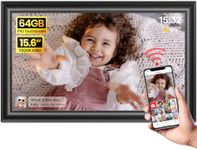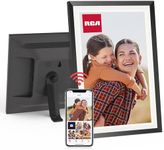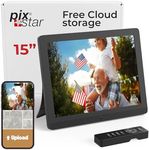Buying Guide for the Best Digital Photo Frame
Choosing a digital photo frame is all about finding a device that displays your favorite memories in a way that fits your space and lifestyle. With so many options available, it's important to think about where you'll place the frame, how you'll use it, and what features matter most to you. By understanding the key specifications, you can make sure you pick a frame that looks great, is easy to use, and keeps your photos looking their best.Screen SizeScreen size refers to the diagonal measurement of the display, usually given in inches. This is important because it determines how large your photos will appear and how much space the frame will take up. Smaller frames (around 7-8 inches) are great for desks or bedside tables, while medium (10-12 inches) and large frames (15 inches or more) are better for living rooms or places where you want your photos to be more noticeable. Think about where you want to put the frame and how far away you'll be viewing it from to decide what size works best for you.
ResolutionResolution tells you how many pixels the screen has, which affects how sharp and clear your photos look. Higher resolution means more detail and less visible pixelation. Common resolutions include 800x600 (basic), 1024x768 (mid-range), and Full HD 1920x1080 or higher (high-end). If you want crisp, detailed images, especially on larger screens, go for a higher resolution. For smaller frames or casual use, a lower resolution may be enough.
Storage OptionsStorage options describe how the frame holds your photos. Some frames have built-in memory, while others use SD cards, USB drives, or cloud storage. Built-in memory is convenient but may be limited, while SD cards and USB drives let you easily swap out photos. Cloud-connected frames can display photos sent from your phone or computer, which is great for sharing with family. Consider how many photos you want to display and how often you want to update them to choose the right storage method.
ConnectivityConnectivity refers to how the frame connects to other devices or the internet. Some frames are 'offline' and only use memory cards or USB, while others have Wi-Fi or Bluetooth. Wi-Fi frames can receive photos remotely, show weather updates, or even connect to social media. If you want to send photos to the frame from anywhere or share with family, look for Wi-Fi connectivity. If you prefer to keep things simple and private, a frame without internet features may be better.
User Interface and ControlsThe user interface and controls determine how easy it is to set up and use the frame. Some frames have touchscreens, while others use buttons or remote controls. Touchscreens are usually more intuitive, especially for changing settings or browsing photos. If you want a frame that's easy for everyone to use, especially kids or older adults, look for simple controls and a clear menu system.
Supported File FormatsSupported file formats are the types of photo and video files the frame can display. Most frames support common formats like JPEG and PNG, but some can also show videos or play music. If you want to display more than just standard photos, check which formats are supported. Make sure the frame can handle the types of files you plan to use.
Additional FeaturesAdditional features can include things like motion sensors (to turn the frame on when someone is nearby), calendar and clock functions, slideshow transitions, or even integration with digital assistants. These extras can make the frame more useful or fun, but aren't necessary for everyone. Think about which features would actually enhance your experience and focus on those when making your choice.



















